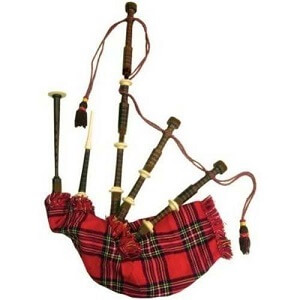Bagpipes
 This is a wind instrument that consists of two or more single- or double-reed pipes. The reeds are vibrated by wind caused by arm pressure on a skin or cloth bag. The pipes are held in wooden sockets tied into the bag, which is inflated either by the mouth or by bellows strapped to the body. Melodies are played on the finger holes of the melody pipe, or chanter, while the remaining pipes, or drones, sound single notes. Bagpipes existed by c. 100 ce. The early bag was an animal bladder or a nearly whole sheepskin or goatskin. Bagpipes have always been folk instruments. An important related instrument is the Irish union (or uilleann) pipes
This is a wind instrument that consists of two or more single- or double-reed pipes. The reeds are vibrated by wind caused by arm pressure on a skin or cloth bag. The pipes are held in wooden sockets tied into the bag, which is inflated either by the mouth or by bellows strapped to the body. Melodies are played on the finger holes of the melody pipe, or chanter, while the remaining pipes, or drones, sound single notes. Bagpipes existed by c. 100 ce. The early bag was an animal bladder or a nearly whole sheepskin or goatskin. Bagpipes have always been folk instruments. An important related instrument is the Irish union (or uilleann) pipes
Bagpipes have always been made in many shapes and sizes, and have been played throughout Europe from before the Norman Conquest until the present day. Medieval pipes usually had a single drone - see contemporary illustrations of Chaucer's Canterbury Tales for English single-drone pipes. Around 1400 (give or take 50 years), most shepherd-style pipes acquired a second drone. A third drone is added about after 1550. See paintings by Brueghel and the illustrations in Praetorius' Syntagma Musicum. The Renaissance also saw the advent of small, quiet chamber pipes such as Praetorius' Hummelchen or the French shuttle-drone models, some blown with bellows under the arm rather than with the mouth.
The bagpipe is ideal for solo dances and monophonic music. It has been mentioned for use in polyphony, but if so, problems would arise. The drone would preclude the possibility of any change of mode, and the continuous sound would prohibit observance of rests.